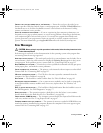
Solving Problems 83
ENSURE THAT YOU ARE CONNECTED TO THE INTERNET —
Ensure that you have subscribed to an
Internet provider. With the Outlook Express e-mail program open, click
File
. If
Work Offline
has a
checkmark next to it, click the checkmark to remove it and connect to the Internet. For help,
contact your Internet service provider.
SCAN THE COMPUTER FOR SPYWARE —
If you are experiencing slow computer performance, you
frequently receive pop-up advertisements, or you are having problems connecting to the Internet,
your computer might be infected with spyware. Use an anti-virus program that includes anti-
spyware protection (your program may require an upgrade) to scan the computer and remove
spyware. For more information, go to
support.dell.com
and search for the keyword
spyware
.
Error Messages
CAUTION: Before you begin any of the procedures in this section, follow the safety instructions in the
Product Information Guide
.
If the message is not listed, see the documentation for the operating system or the program that
was running when the message appeared.
AUXILIARY DEVICE FAILURE — The touch pad, track stick, or external mouse may be faulty. For an
external mouse, check the cable connection. Enable the Pointing Device option in the system
setup program. If the problem persists, contact Dell. See "Contacting Dell" on page 145.
BAD COMMAND OR FILE NAME — Ensure that you have spelled the command correctly, put spaces
in the proper place, and used the correct pathname.
CACHE DISABLED DUE TO FAILURE — The primary cache internal to the microprocessor has failed.
Contact Dell. See "Contacting Dell" on page 145.
CD DRIVE CONTROLLER FAILURE — The CD drive does not respond to commands from the
computer. See "Drive Problems" on page 80.
DATA ERROR — The hard drive cannot read the data. See "Drive Problems" on page 80.
DECREASING AVAILABLE MEMORY — One or more memory modules may be faulty or improperly
seated. Reinstall the memory modules and, if necessary, replace them. See "Memory" on
page 112.
DISK C: FAILED INITIALIZATION — The hard drive failed initialization. Run the hard drive tests in
the Dell Diagnostics. See "Dell Diagnostics" on page 77.
DRIVE NOT READY — The operation requires a hard drive in the bay before it can continue.
Install a hard drive in the hard drive bay. See "Hard Drive" on page 108.
ERROR READING PCMCIA CARD — The computer cannot identify the ExpressCard. Reinsert the
card or try another card. See "Using ExpressCards" on page 67.
EXTENDED MEMORY SIZE HAS CHANGED — The amount of memory recorded in NVRAM does not
match the memory installed in the computer. Restart the computer. If the error appears again,
contact Dell. See "Contacting Dell" on page 145.
book.book Page 83 Wednesday, October 26, 2005 1:00 PM


















